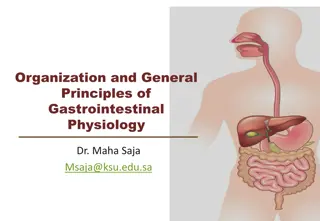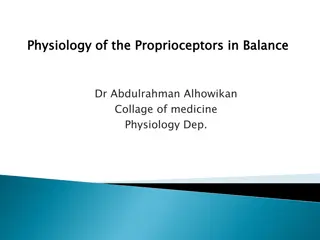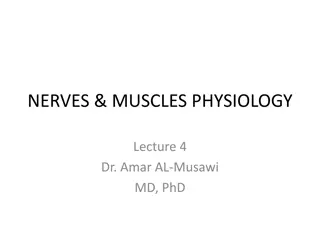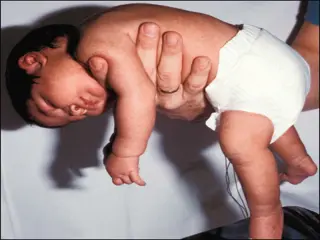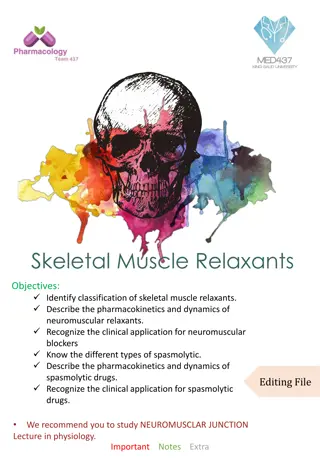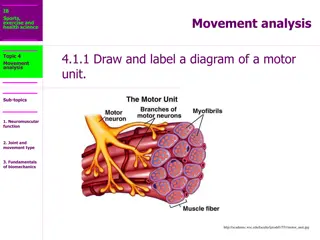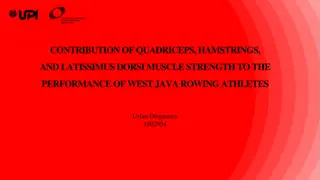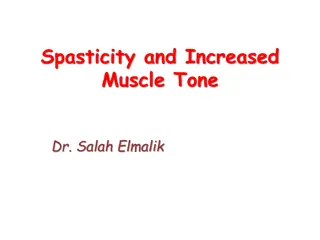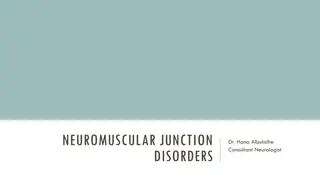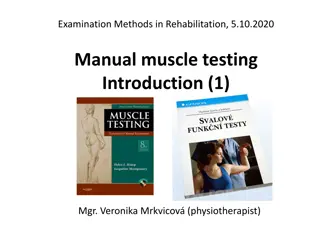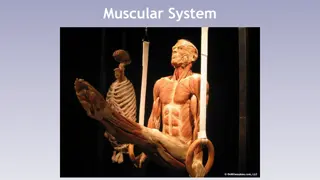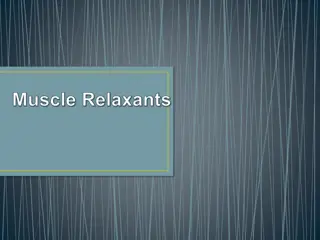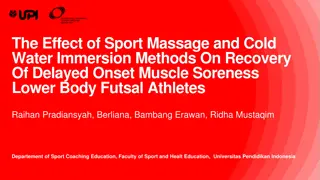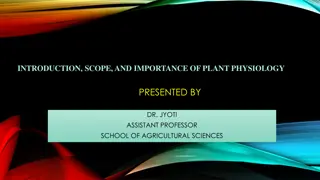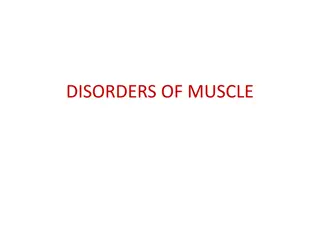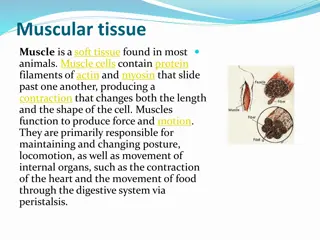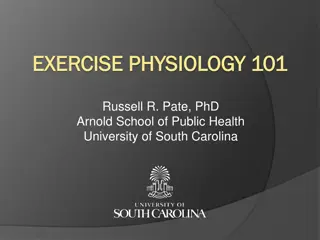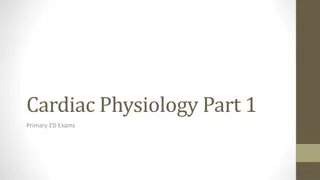The muscular system
The muscular system is a vital organ system that includes smooth, skeletal, and cardiac muscles. It plays a crucial role in locomotion, supporting the cardiovascular system, enabling lung ventilation, regulating fluids, maintaining posture, and generating heat in the body. This system consists of ar
2 views • 16 slides
Skeletal Muscle Relaxants and Neuromuscular Blockade
Skeletal muscle relaxants are used to induce muscle relaxation during surgeries. Neuromuscular blocking agents act at the neuromuscular junction. These drugs can either peripherally reduce muscle tone or centrally cause muscle paralysis. Different types of muscle relaxants are classified based on th
6 views • 23 slides
Unveiling the Best Mass Gainers in India for Maximum Muscle Growth
Discover the ultimate solution for achieving your muscle-building goals with the best mass gainers available in India. Our comprehensive guide delves into the top-rated products designed to support your mass gain journey effectively. Whether you're a beginner or a seasoned fitness enthusiast, these
6 views • 1 slides
Boost Muscle Tone and Recovery with EMSFuse in Just 15 Minutes a Day!
Experience Enhanced Muscle Toning with EMSFuse: Revolutionize your fitness routine with EMSFuse, the cutting-edge solution for muscle toning and recovery. Harness the benefits of EMS to build stronger muscles, alleviate pain, and speed up healing. Achieve optimal fitness results in just 15 minutes d
1 views • 8 slides
ASCCC OERI Webinar on OER for Anatomy, Physiology, and Microbiology
Welcome to the ASCCC OERI webinar focused on Open Educational Resources (OER) for Anatomy, Physiology, and Microbiology. This event discusses the adoption of OER in California Community Colleges, challenges faced in Anatomy and Physiology, available resources, and potential strategies to increase OE
0 views • 20 slides
Essential Overview of Gastrointestinal Physiology
Exploring the organization and general principles of gastrointestinal physiology, this content covers the anatomical and functional aspects of the GI system, including smooth muscle characteristics, neural control, blood flow, nutrient absorption, waste excretion, and regulatory functions like immun
0 views • 46 slides
Understanding Proprioceptors and Their Role in Body Balance
Proprioceptors play a crucial role in providing information about the position of body parts, muscle spindle response to stretch, and muscle tension regulation. Muscle spindles and Golgi tendon organs are key components in maintaining muscle tone and ensuring proper reflex actions. This article delv
1 views • 23 slides
Animal Muscle Identification and Anatomy Diagrams
This collection includes detailed diagrams showcasing the identification and anatomy of muscles in animals, specifically focusing on pig muscle anatomy. From head and neck muscles to arm and shoulder muscles, pelvis and thigh muscles, and trunk muscles, these visual aids help understand the structur
3 views • 26 slides
Muscle Contraction Phases and Responses: A Comprehensive Overview
Various changes observed during muscle contraction include the latent period, contraction phase, and relaxation phase. Muscle twitch, tetanus, and their durations are important phenomena in understanding muscle physiology.
0 views • 14 slides
Understanding Nerves and Muscles Physiology - Lecture Insights
Explore the intricate processes of synaptic transmission, neurotransmitters, spatial summation, temporal summation, chemical substances acting as neurotransmitters, and the effects of various factors and drugs on synapse function. Delve into the clinical significance of sedative-hypnotic drugs and t
0 views • 11 slides
Understanding Hypotonia in Infants: Causes, Evaluation, and Management
Hypotonia, which is reduced muscle tone, can present challenges in infants affecting their motor skills and posture. This article explores the definitions, physiology, differences in central and peripheral causes, evaluation methods, and management options for hypotonia. It discusses relevant termin
0 views • 40 slides
Skeletal Muscle Relaxants: Classification, Pharmacokinetics, and Clinical Applications
Skeletal muscle relaxants encompass different types, including neuromuscular blockers, spasmolytic drugs, and peripherally-acting agents. They are classified based on mechanisms of action and play crucial roles in inducing skeletal muscle relaxation for various clinical applications. Understanding t
3 views • 12 slides
Understanding Electromyography (EMG) and Motor Neurons
Electromyography (EMG) is an electrodiagnostic technique used to evaluate muscle health by measuring electrical activity. EMG measures muscle response to nerve signals, displayed as waves on an oscilloscope. Motor neurons transmit signals from the brain to muscles, enabling movement. Upper motor neu
2 views • 8 slides
Understanding the Histological Structure of Muscle Cells
This presentation delves into the histological structure of three types of muscle cells - skeletal, cardiac, and smooth muscles. Learn about their differences, such as striation, voluntary vs. involuntary control, and cellular organization. Discover the components of muscular tissue, the coverings o
0 views • 13 slides
Understanding Motor Units and Neurotransmitters in Muscle Contraction
Motor units consist of a motor neuron and the muscle fibers it innervates. Neurotransmitters like acetylcholine play a vital role in stimulating muscle contraction by transmitting signals at the neuromuscular junction. This communication between neurons and muscles is essential for proper movement a
0 views • 30 slides
Introduction to Plant Physiology: Exploring the Functioning of Plants
Plant physiology is a crucial subdiscipline of botany that delves into the processes and functions operating within plants. This field closely examines areas like plant morphology, ecology, cell biology, and genetics, shedding light on vital processes such as photosynthesis, respiration, and more. T
1 views • 7 slides
Impact of Plyometric Jump Training on Leg Muscle Power in Badminton Athletes
Plyometric jump to box and double leg hop training can significantly improve leg muscle power in badminton athletes, enhancing their ability to execute powerful smashes. This study focuses on the effects of specific plyometric exercises on leg strength essential for optimal badminton performance. Th
0 views • 9 slides
Understanding Chlorophyll Fluorescence in Plant Physiology
Chlorophyll fluorescence is a powerful tool developed in the 1990s for studying plant physiology and stress. It provides insights into photosynthetic processes at different levels, from subcellular to canopy. By measuring chlorophyll fluorescence, researchers can assess the efficiency of photosynthe
0 views • 16 slides
Contribution of Quadriceps, Hamstrings, and Latissimus Dorsi Muscle Strength to Rowing Performance in West Java
Rowing is a demanding sport that requires strong leg muscle strength for optimal performance, particularly in West Java where rowing athletes train. This study aims to investigate the contribution of quadriceps, hamstrings, and latissimus dorsi muscle strength to the performance of rowing athletes i
0 views • 16 slides
Exploring the Fascinating World of Biology and Human Biology
Biology is a broad scientific field encompassing the study of living organisms and their various aspects, from anatomy and physiology to genetics and evolution. Branches of biology include anatomy, histology, cytology, physiology, embryology, genetics, molecular biology, biochemistry, zoology, botan
0 views • 21 slides
Understanding Spasticity and Increased Muscle Tone in Neurological Disorders
Spasticity and increased muscle tone are common features in neurological disorders, characterized by hyperactive stretch reflexes and muscle contractions. Spasticity is velocity-dependent and associated with upper motor neuron lesions, leading to increased resistance to passive movement. Rigidity, o
0 views • 28 slides
Sniff Nasal Inspiratory Pressure (SNIP): Assessing Respiratory Muscle Strength
SNIP is a sensitive non-invasive test that measures inspiratory muscle strength by assessing nasal pressures during a sniff maneuver. It is a valuable tool for early detection of respiratory muscle decline, providing insights into potential threats like hypercapnic respiratory failure, impaired coug
0 views • 11 slides
Overview of Appendicular Skeleton and Bones by Dr. Mahdi H. Hammadi, PhD, Sc. Clinical Physiology
Dr. Mahdi H. Hammadi, PhD, Sc. in Clinical Physiology, provides an insightful look into the bones of the appendicular skeleton, including the shoulder girdle, upper limbs, wrist bones, and hand bones. The text covers the composition and functions of these skeletal elements in a comprehensive manner,
0 views • 21 slides
Understanding Animal Tissues: Epithelial, Muscle, Nerve, and Connective Tissues
Explore the four general categories of animal tissue - epithelial, muscle, nerve, and connective tissues. Learn about the traits, classification, examples, and functions of each type of tissue. From the tightly packed cells of epithelial tissue to the excitable nature of muscle tissue, delve into th
1 views • 22 slides
Understanding Neuromuscular Junction Disorders with Dr. Hana Albulaihe
An in-depth exploration of neuromuscular junction (NMJ) anatomy, physiology, and associated disorders by Dr. Hana Albulaihe, a renowned Consultant Neurologist. The NMJ comprises the axon terminal of a motor neuron and the motor end plate of a muscle fiber. Disorders discussed include Myasthenia grav
0 views • 75 slides
Understanding Types of Muscle Actions in Physiology
Explore different types of muscle actions, including isometric contractions, isotonic contractions, concentric contractions, eccentric contractions, isokinetic contractions, and iso-inertial contractions. Each type plays a crucial role in muscle function and movement, with varying effects on muscle
0 views • 14 slides
Importance of Manual Muscle Testing in Rehabilitation
The assessment of muscle function is crucial in various medical exams, showing correlations with quality of life, work productivity, and aging-related issues. Manual muscle testing is commonly used by healthcare professionals to evaluate muscle strength and guide treatment plans. Assessing muscle fu
0 views • 54 slides
Understanding the Muscular System and Its Anatomy
The muscular system is vital for movement, posture maintenance, and organ protection. It consists of skeletal muscles that contract to create movement, circular muscles called sphincters for controlling openings, and muscle fibers arranged in fascicles with collagen layers like epimysium and endomys
0 views • 59 slides
Understanding Muscle Relaxants: Mechanisms and Applications
Muscle relaxants play a crucial role in managing conditions like spasticity and painful spasms. Centrally active agents modulate motor impulses in the spinal cord and CNS, while peripherally active agents target neuromuscular junctions. Baclofen, benzodiazepines, and other specific drugs serve vario
0 views • 13 slides
The Effect of Sport Massage and Cold Water Immersion on Muscle Soreness Recovery in Futsal Athletes
A study investigated the impact of sport massage and cold water immersion on recovery from delayed onset muscle soreness in lower-body futsal athletes. Results indicated that cold water immersion had a more significant effect on recovery compared to sport massage. The cold-water immersion method sho
0 views • 7 slides
Understanding the Significance of Plant Physiology in Agriculture
Plant physiology plays a crucial role in understanding how plants adapt to various environmental conditions, develop mechanisms to cope with stress, and optimize their growth and productivity. This branch of botany explores the structural and functional aspects of plants, delving into cellular, bioc
0 views • 11 slides
Understanding Skeletal Muscle Relaxants and Muscle Contraction Mechanisms
Skeletal muscle relaxants play a crucial role in relaxing muscles without affecting consciousness significantly. They are classified into neuromuscular blockers and spasmolytics, each targeting different mechanisms in the body. Muscle contraction occurs through the release of acetylcholine and the s
0 views • 27 slides
Understanding Connective Tissue Wrappings and Skeletal Muscle Structure
Exploring the connective tissue wrappings and attachments of skeletal muscles, this content highlights the cord-like structures, collagen fibers, and their role in connecting muscle bellies to bones. It also delves into the surrounding connective tissues such as fascia, epimysium, perimysium, and en
0 views • 11 slides
Overview of Muscle Disorders and Muscular Dystrophies
The human body consists of over 600 muscles, divided into skeletal, smooth, and cardiac muscles. Diseases of skeletal muscle encompass myopathy, myositis, and muscular dystrophy. Muscle disorders are categorized into genetic muscular dystrophies, channelopathies, inflammatory myopathies, and endocri
0 views • 32 slides
Understanding Muscle Tissue: Structure and Function
Muscle tissue is a vital component in most animals, facilitating movement and maintaining posture. Derived from embryonic cells, muscles come in three types: skeletal, cardiac, and smooth, each serving specific functions in the body. While skeletal muscles are under voluntary control, cardiac and sm
0 views • 15 slides
Understanding Basic Histology and Tissue Types
Explore histology, tissues, and types of tissues including epithelial, connective, muscle, and nerve tissues. Learn about tissue characteristics, differences, and functions, as well as details on specific tissue types like cardiac muscle, bone tissue, skeletal muscle, and smooth muscle. Delve into e
0 views • 74 slides
Understanding Exercise Physiology Fundamentals
Explore the basics of exercise physiology, including physiologic responses to acute exercise, functional adaptations to chronic exercise, and the mediation of health effects. Learn the difference between physical activity and exercise, the concept of work in exercise, and the energy expenditure invo
0 views • 31 slides
Understanding the Urinary System: Bladder Anatomy and Function
Exploring the anatomy and physiology of the urinary system with a focus on the bladder, including details on muscle structure, capacity for urine collection, and the role of the detrusor muscle in micturition. Learn about key components such as the trigone and bladder neck, as well as innervation an
0 views • 19 slides
Muscular System Jeopardy - Learn About Muscle Functions and Facts
Explore the Muscular System Jeopardy game to understand how muscles work, muscle group names, exercises to build muscles, and the importance of healthy muscles. Discover interesting facts about muscle function, including how messages from the brain trigger muscle contractions, the role of tendons in
0 views • 52 slides
Understanding Cardiac Physiology: Electrical System and Excitation
Explore the intricate details of cardiac physiology, focusing on the electrical conducting system, spread of excitation, ECG interpretation, action potentials, and hemodynamic parameters. Learn about pacemaker cells, differences between ventricular and pacemaker action potentials, and the initiation
0 views • 26 slides





